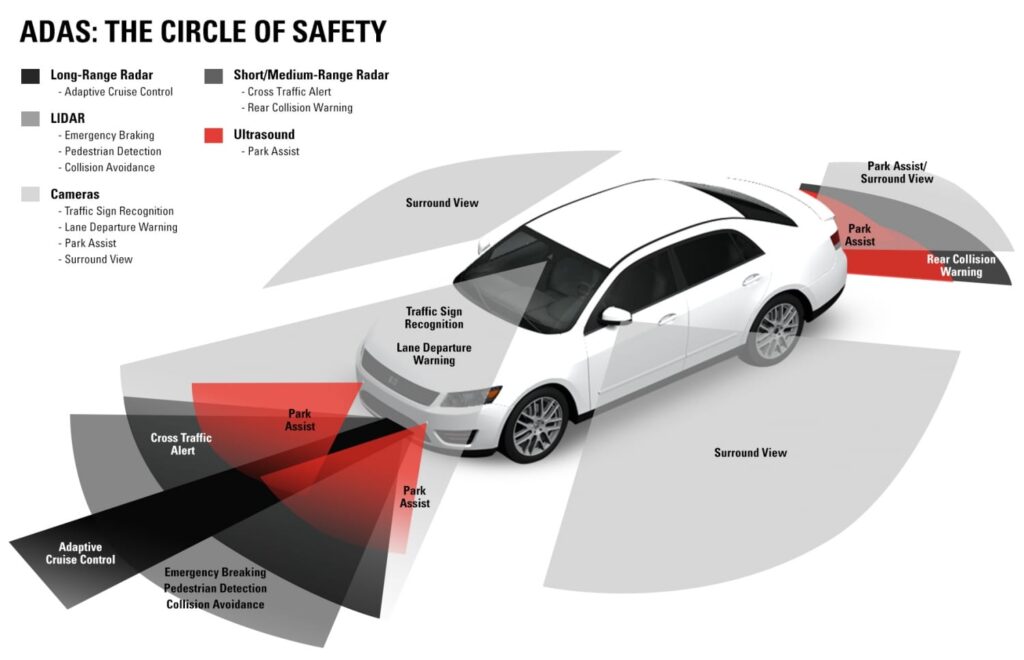Driver assistance technologies hold the potential to reduce traffic crashes and save thousands of lives each year. In 2021, 42,939 people died in motor vehicle crashes — many of these crashes were tied to human error. Learn more about driver assistance technologies, how they can help you, and what you should know about these technologies when buying your next vehicle. The four major
Forward Collision Warning
A forward collision warning system monitors the vehicle’s speed, the speed of the vehicle in front of it, and the distance between the vehicles. If the vehicle gets too close to the vehicle ahead, the system will warn the driver of an impending crash. It’s important to note that forward collision warning systems only provide a warning to the driver and do not take action to avoid a crash.
Lane Departure Warning
A lane departure warning system monitors lane markings and alerts the driver when it detects that the vehicle is drifting out of its lane. It’s important to note that a lane departure warning system only provides a warning to the driver and does not take action to avoid a crash.
Rear Cross Traffic Warning
Rear cross traffic warning alerts the driver of potential collisions, while in reverse, that may be outside the view of the backup camera.
Blind Spot Warning
Blind spot warning systems alert drivers with an audio or visual warning if there are vehicles in adjacent lanes that the driver may not see when making a lane change.
Adaptive Cruise Control
Adaptive cruise control automatically adjusts the vehicle’s speed to keep a pre-set distance between it and the vehicle in front of it.
Lane Centering Assistance
Lane-centering assistance utilizes a camera-based vision system designed to monitor the vehicle’s lane position and automatically and continuously apply steering inputs needed to keep the vehicle centered within its lane.
Lane Keeping Assistance
Lane-keeping assistance helps prevent the vehicle from unintentionally drifting out of its lane. The system uses information provided by lane departure warning sensors to determine whether the vehicle is about to unintentionally move out of its lane of travel. If so, the system activates and corrects the steering, brakes, or accelerates one or more of the wheels, or does a combination of both, resulting in the vehicle returning to its intended lane of travel.
Automatic High Beams
Automatic high beams automatically switch the vehicle’s headlights between the lower beam and the higher beam, based on lighting conditions and traffic, when an oncoming vehicle approaches. This technology, also known as semi-automatic beam-switching headlamps, uses photometric sensors or onboard cameras to detect when to switch between high and low beams.
Backup Camera
A backup camera, also known as a rearview video system, helps prevent backover crashes and protect our most vulnerable people — children and senior citizens. By providing an image of the area behind the vehicle, a backup camera helps the driver see behind the vehicle while in reverse. It’s important to remember that backup cameras are not a replacement for mirrors or turning around to look. As of May 2018, NHTSA requires this lifesaving technology on all new vehicles. Watch how it works.
Automatic Crash Notification
An automatic crash notification system is designed to notify emergency responders that a crash has occurred and provide its location. In most cases, when the system detects that an air bag has deployed or that there’s been a dramatic and sudden deceleration, the system automatically connects to an operator, who will then be able to communicate with the driver. The operator is also able to collect basic information from the vehicle, without driver input, to provide to emergency responders so they can easily locate the scene of the crash. Automatic crash notification systems can reduce death and disability by decreasing the time it takes for emergency medical services to arrive at a crash scene and transport victims to a hospital.

